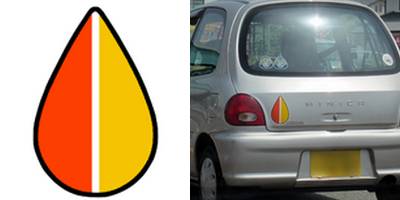
The Kōreisha mark (高齢者マーク, elderly car mark) is a statutory sign that is set up in the Road Traffic Law of Japan to indicate “aged person at the wheel”. Its official name is “aged driver sign” (高齢運転者標識, kōrei untensha hyōshiki).
The law decrees that when a person who is aged 70 and over drives a car and if his/her old age could affect the driving, he/she should endeavor to display this mark on both the front and rear of the car. Drivers aged 75 and over are obliged to display the mark.
Conversely, the green and yellow shoshinsha mark or wakaba mark denotes new drivers. Both marks are designed to warn other drivers that the marked driver is not very skilled, either due to inexperience or old age.

The system was instituted in 1997; until January 2011, its shape was an orange and yellow teardrop-shape, and it was accordingly also called “momiji mark” (紅葉マーク, autumn leaf mark). Some people call it “kareha mark” (枯れ葉マーク, dried leaf mark) or “Ochiba mark” (落葉マーク, fallen leaf mark), but this is a more informal title, and considered less polite.
Senior drivers didn’t like the old symbol because the orange and yellow autumn leaf represented death.
As of 1 February 2011, the shape was changed to the new, 4-leafed form. The new form was selected on a nation-wide contest. The four-color clover is created by a 31-year-old graphic designer from Osaka.

